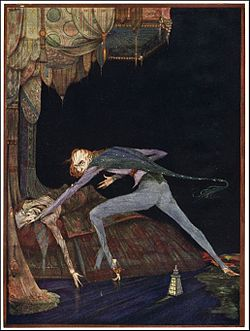Edgar Allan Poe is an author of dozens of masterpieces, especially in the tales of mysteries. One of his most famous works is “The Tell-Tale Heart,” a mystery story that is considered one of the classic works of a Gothic genre. Except for puzzling and enigmatic plot, the way how Edgar Allan Poe constructed a narration style is worthy of appraisal.
It is also assumed that symbolism in “The Tell-Tale Heart” deserves much attention, especially after re-reading this short story. Let’s find out how symbols in Edgar Allan Poe’s “The Tell-Tale Heart” convey senses and meanings previously unavailable to understand. Read on.

Notes on the plot
Let us briefly remind you of the main elements of The Tell-Tale Heart plot, which might be relevant for understanding the power of symbolism. This puzzling literature is told from the first-person narrative of an unnamed narrator who thinks that an old man, a narrator neighbor, and his vulture eye is responsible for his distress. Subsequently, a narrator realizes that if the crime is planned and executed in careful precision, his sanity will end once and forever.
After carefully planning his actions of shining a sliver of light onto an old man’s eye for seven nights, on the eighth night, a tragic event finally takes place. After hearing an old man’s heartbeat, a narrator opens the lantern, eventually smothering an old man in his bedroom. The murder is followed by dismembering his body parts and concealing them under the floorboards of the apartment.
During a murder, an old man’s screaming was heard by a neighbor who eventually reported screaming to the police. During police visit, a narrator calls the police that he is innocent by indicating that the scream heard was of his own. A tragic feature is that a whole conversation took place on the spot where the remains were hidden.
The story ends with a narrator’s distress, who feels uncomfortable with noises, which were believed to be an old man’s heart beating. Even though only a narrator heard these noises, but not the police officers, a narrator eventually breaks down and confesses about his crimes.
With such powerful writing, symbolism can be found virtually anywhere, ranging from a lantern and a bedroom to the heart and an eye.
.png?1594387901579)
Main symbols of the story
In most literature study guides, it is common to agree that both an eye and the heart are objects that serve to be the main symbols of a story. In terms of an eye, it is continually portrayed in this story as a “vulture” one, which is a bird that feeds on one’s dead flesh. This symbol refers to death and preying on another, whereas its blue palette color also represents coldness in the intentions to kill the old man. In The Tell Tale Heart, an eye represents an object that watches a narrator continually, eventually becoming its main motivation to kill. Some study guides also point out that an eye is also a symbol of wisdom, meaning that despite a narrator performing evil endeavors, a motivation of such actions still remains uncertain.
Except for an eye, which plays a central role, the heart represents all horrors of murder more vibrantly. Any study guide will agree that while an eye literally controls a narrator, those heart beats represent that all crimes can haunt people. The source of those noises was unclear, with most study guides claiming that those sounds were of a narrator’s own body. Still, the symbolism of haunting that can emerge even after one is dead and buried is a strong connotation that has to be mentioned.
Another symbol that has to be included in a study guide refers to a house. By accepting guilt in the minute hand that he is responsible for the death of an old man, a narrator symbolically tries to hide a crime in his subconscious. The same goes for hiding dismembered remains of an old man beneath the floorboards. An entire crime scene symbolically represents an attempt to hide the subconscious. Since all the subconscious acts always return, a last-minute confession can be seen as a leaked truth.
.png?1594387985811)
Worthwhile mentionings
Even though the major symbolic objects are mentioned above, a few minor references deserve attention due to their importance for understanding this story. In any study guide, it is common to say that death watches that attract mates are references to beatles who bang their heads. This element refers to a widespread belief that these bangs represent a countdown to someone’s demise.
Another element in Edgar Allan Poe’s “The Tell-Tale Heart” that symbolizes a dichotomy is a bedroom itself. When a narrator hears that an old man woke up during the last night of his life, a bedroom represents a person’s vulnerability. In our study guide, we find it relevant to mention that bed also represents a relative safety of a person sleeping. In turn, according to the narrator’s point of view, the bed is the murder weapon that can turn a person into a dead state, eventually evoking a sense that it can become a burial place.
.png?1594388056683)
Final remarks
With numerous symbols throughout this story, The Tell-Tale Heart study guide is a decent chance to take a closer look at all references made by Poe. While a narrator accepts his guilt and confesses at the end of this story, these symbols allow understanding motivations and minor references made by the author. Such an analysis allows tracing what Poe meant by portraying a puzzling and enigmatic story of a Gothic murder with a follow-up confession.

